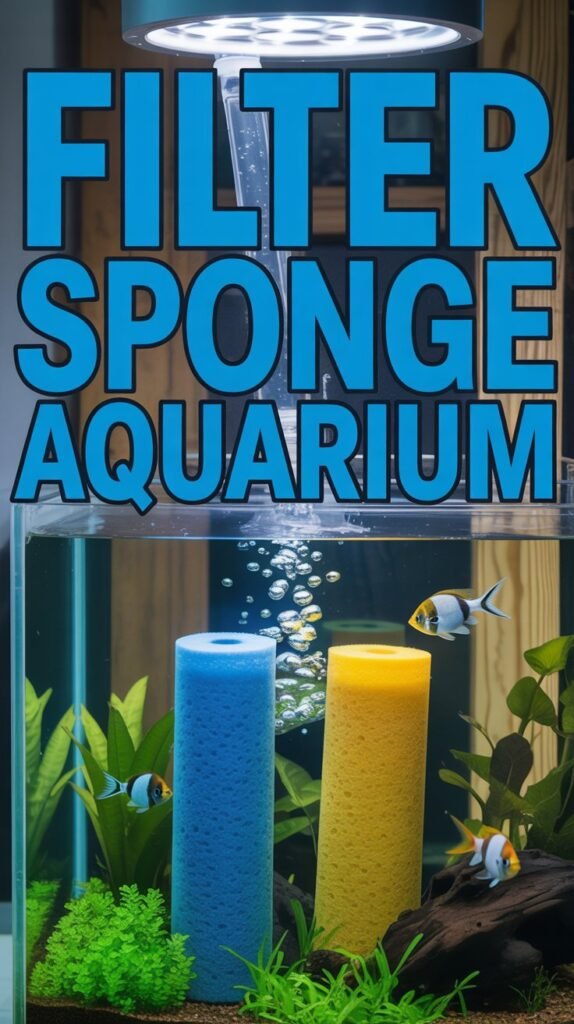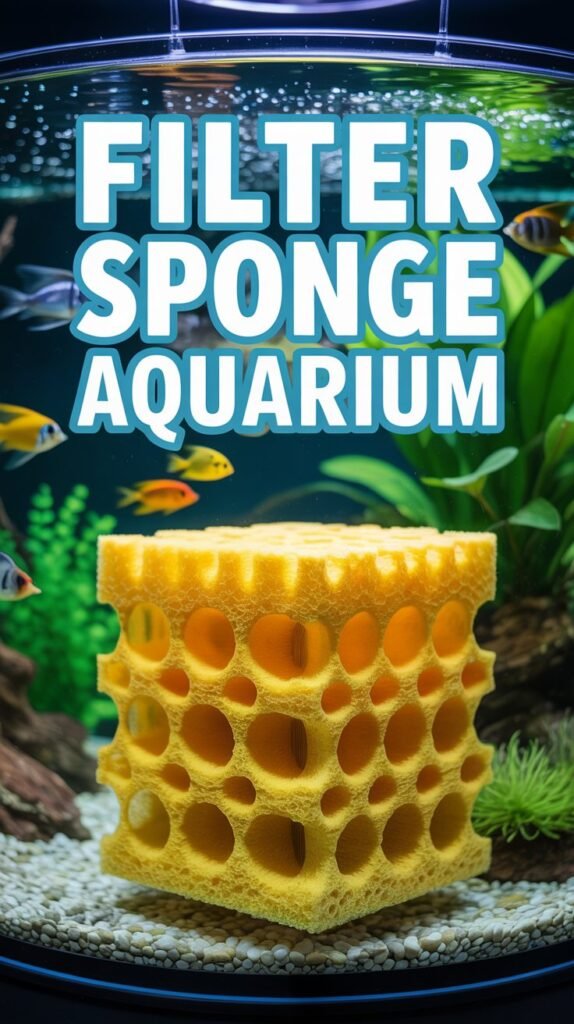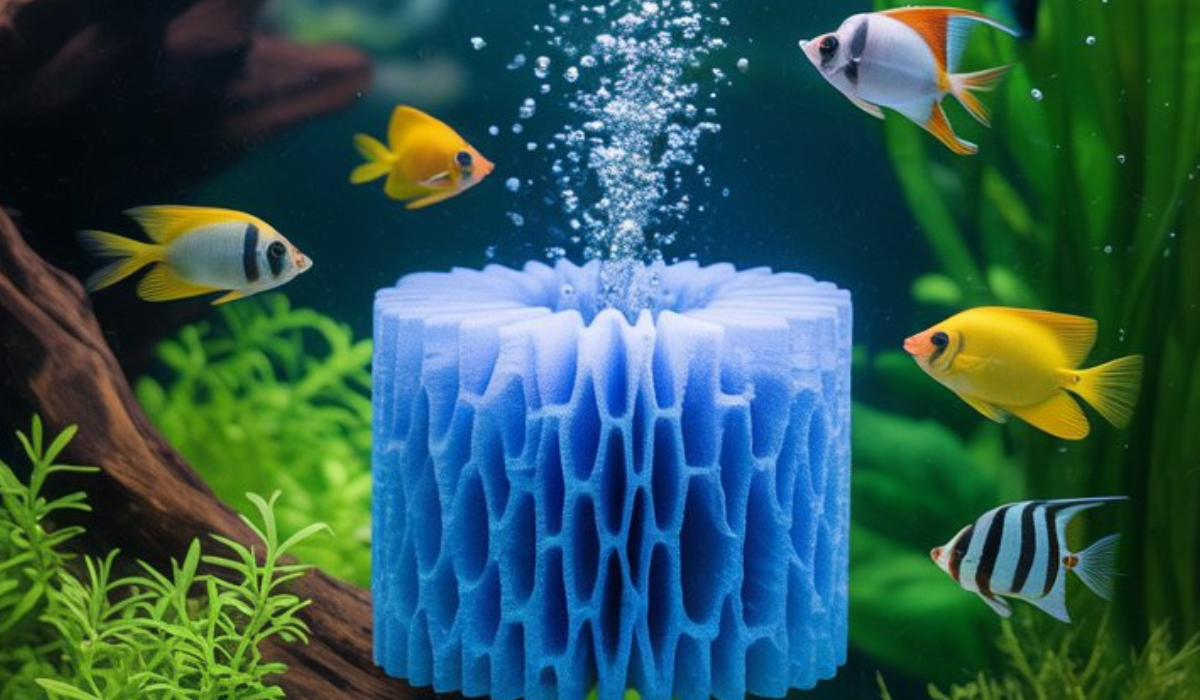Aquarium filtration is the backbone of a healthy fish tank. Without proper filtration, waste, toxins, and uneaten food quickly build up, creating an unsafe environment for your aquatic pets. Among the various filtration methods available today, the filter sponge aquarium setup remains one of the most versatile, affordable, and beginner-friendly solutions.
Whether you own a small betta bowl, a shrimp tank, or a fully stocked tropical aquarium, a filter sponge can play a crucial role in maintaining crystal-clear and biologically stable water. This comprehensive guide will cover what sponge filters are, how they work, their benefits, setup instructions, maintenance tips, and much more.
What Is a Filter Sponge Aquarium?
A filter sponge aquarium refers to an aquarium filtration system that uses a sponge filter as its main or supplementary filter. The sponge acts as a mechanical and biological filtration medium, trapping debris while providing an ideal surface for beneficial bacteria to grow.
These filters are powered either by an air pump (for traditional sponge filters) or by water flow from a powerhead or canister filter (for sponge pre-filters). The sponge filter’s simplicity, efficiency, and cost-effectiveness make it a favorite among hobbyists — especially those keeping shrimp, fry, or small fish.
How Does a Sponge Filter Work?

A sponge filter operates on a simple but effective principle: air-driven suction and biological filtration.
Here’s how it works step by step:
- Air Pump Connection:
An air pump pushes air through airline tubing into the sponge filter’s airlift tube. - Bubble Formation:
The rising bubbles create an upward current, pulling aquarium water through the sponge’s porous surface. - Mechanical Filtration:
As water passes through the sponge, debris, waste particles, and uneaten food get trapped in the sponge’s pores. - Biological Filtration:
Over time, beneficial nitrifying bacteria colonize the sponge surface. These bacteria convert toxic ammonia into nitrite and then into nitrate, making the water safe for fish. - Clean Water Return:
The filtered water flows back into the aquarium, completing the cycle.
This dual-filtration process ensures continuous water clarity and excellent biological stability.
Types of Filter Sponges for Aquariums
Sponge filters come in several types and configurations depending on your tank size, setup, and filtration needs.
1. Single Sponge Filters
- Best for small tanks (under 20 gallons).
- Simple design with one sponge and an airlift tube.
- Perfect for betta, shrimp, and quarantine tanks.
2. Double Sponge Filters
- Feature two sponges for increased filtration surface.
- Ideal for medium tanks (20–50 gallons).
- Allow easy cleaning by alternating between sponges.
3. Corner Sponge Filters
- Designed to fit neatly into tank corners.
- Suitable for tanks where space and aesthetics matter.
4. Sponge Pre-Filters
- Attach to the intake tube of a canister or HOB (Hang-On-Back) filter.
- Prevent fish, shrimp, and debris from entering the main filter.
- Extend the lifespan of your primary filtration system.
5. Powerhead Sponge Filters
- Combine sponge filtration with a water pump or powerhead for increased flow.
- Great for larger aquariums or tanks that need extra water circulation.
Benefits of Using a Filter Sponge in an Aquarium

Sponge filters may look simple, but they offer numerous advantages for both beginners and advanced aquarists.
1. Excellent Biological Filtration
The porous structure of the sponge provides massive surface area for beneficial bacteria to grow. These bacteria are vital for the nitrogen cycle, helping to keep ammonia and nitrite at safe levels.
2. Safe for Fry and Shrimp
Unlike powerful filters that can suck in small creatures, sponge filters are gentle and safe for shrimp, baby fish (fry), and delicate species. They provide gentle water flow and even serve as feeding grounds for shrimp that graze on biofilm.
3. Affordable and Low Maintenance
Sponge filters are among the most budget-friendly filtration systems available. They have no complex moving parts and require minimal maintenance.
4. Aeration and Oxygenation
Because they use air pumps, sponge filters increase oxygen levels in the water, promoting a healthier environment for fish and beneficial bacteria.
5. Easy to Clean
Cleaning involves simply squeezing the sponge in aquarium water to remove debris — no disassembly or chemical cleaning needed.
6. Customizable Setup
Sponge filters can be used alone or in combination with canister or HOB filters for multi-layered filtration.
7. Durable and Long-Lasting
High-quality sponge filters can last for years if properly maintained, providing excellent long-term value.
Drawbacks of Sponge Filters
While sponge filters have many advantages, it’s important to understand their limitations.
- Limited Mechanical Filtration:
They can’t remove very fine particles as effectively as chemical or canister filters. - Not Ideal for Large Tanks Alone:
In tanks over 75 gallons, a sponge filter may not provide adequate water movement or debris removal. - Visible Equipment:
Since sponge filters sit inside the tank, they may not look aesthetically pleasing in aquascaped or display aquariums. - Dependence on Air Pump:
Requires a reliable air pump and tubing, which can be slightly noisy.
Despite these drawbacks, sponge filters remain incredibly useful when used correctly or as part of a multi-filter system.
How to Choose the Right Filter Sponge for Your Aquarium
Selecting the perfect sponge filter depends on several key factors:
1. Tank Size
- Small tanks (5–20 gallons): Single sponge filters are sufficient.
- Medium tanks (20–50 gallons): Go for double sponge filters or a powerhead-driven sponge filter.
- Large tanks (50+ gallons): Use multiple sponge filters or pair them with other filtration systems.
2. Aquarium Type
- Fry and shrimp tanks: Soft-flow single or double sponge filters.
- Community tanks: Dual sponge filters for better biofiltration.
- Hospital/quarantine tanks: Simple sponge filter with adjustable airflow.
3. Sponge Pore Size
- Fine-pore sponges trap smaller debris and are great for fry tanks.
- Coarse-pore sponges allow more water flow and are ideal for established tanks with heavy bio-loads.
4. Air Pump Strength
Choose an air pump powerful enough to drive sufficient water through the sponge without creating excessive turbulence.
5. Build Quality
Opt for durable sponges with sturdy bases and high-quality airline tubing connections to ensure long-term reliability.
How to Set Up a Sponge Filter in Your Aquarium

Installing a sponge filter is straightforward. Follow these steps for a successful setup:
Step 1: Unbox and Inspect
Ensure all components — sponge, uplift tube, base, and airline connector — are included and undamaged.
Step 2: Rinse the Sponge
Rinse the sponge filter under dechlorinated or tank water to remove dust and residue from packaging.
Step 3: Connect the Airline Tubing
Attach one end of the airline tubing to your air pump and the other end to the sponge filter inlet.
Step 4: Place the Filter in the Tank
Position the filter inside your aquarium. Place it along a wall or corner to maximize aesthetics and flow distribution.
Step 5: Turn on the Air Pump
Power up the air pump. You’ll see bubbles rising through the lift tube, indicating that water is circulating through the sponge.
Step 6: Adjust the Flow
If bubbles are too vigorous, use an air valve to reduce flow. For delicate species, gentle bubbling is ideal.
Step 7: Cycle the Aquarium
Allow time for beneficial bacteria to colonize the sponge (usually 2–4 weeks). During this period, avoid overfeeding and monitor ammonia and nitrite levels.
Maintenance Tips for Sponge Filters
Regular maintenance keeps your sponge filter performing optimally.
1. Clean Monthly
Every 2–4 weeks, remove the sponge and rinse it gently in old tank water. Never use tap water, as chlorine kills beneficial bacteria.
2. Avoid Over-Cleaning
Don’t scrub or squeeze too hard — this removes the helpful bacteria that handle biological filtration.
3. Replace When Needed
Sponge filters last long, but after 1–2 years, the sponge may deteriorate. Replace it when it loses elasticity or starts breaking apart.
4. Check Airflow
Ensure the air pump is working efficiently and the airline tubing isn’t kinked or clogged.
5. Combine with Other Filtration
For larger tanks or heavy bio-loads, pair your sponge filter with a canister filter or hang-on-back filter for best results.
Combining Sponge Filters with Other Systems
Many aquarists use sponge filters in combination with other filtration systems to create a balanced setup.
1. Sponge + Canister Filter
Use a sponge pre-filter on your canister intake. This prevents clogging and protects small fish and shrimp.
2. Sponge + Hang-On-Back Filter
The sponge provides biological filtration while the HOB handles chemical and mechanical filtration.
3. Sponge + Air Stones
For extra oxygenation, you can install air stones within the sponge filter tubing to produce finer bubbles.
Best Situations to Use Sponge Filters
Sponge filters shine in several specific aquarium setups:
- Breeding tanks: Gentle filtration prevents fry from being sucked in.
- Shrimp tanks: Provides biofilm and grazing surface for shrimp.
- Quarantine tanks: Keeps water cycled without harsh flow.
- Hospital tanks: Offers filtration without medication absorption (unlike carbon filters).
- Backup filtration: Works great as an emergency or backup filter in case of power or equipment failure.
Troubleshooting Common Sponge Filter Problems
1. Low Bubble Output
- Check for clogged airline tubing or a weak air pump.
- Clean the air stone or replace it if blocked.
2. Reduced Water Flow
- Sponge may be clogged with debris. Clean it in tank water.
- Check that the sponge is not too compressed or damaged.
3. Noise from Air Pump
- Place a rubber pad under the air pump to minimize vibration.
- Clean or replace the air pump diaphragm if it’s worn out.
4. Cloudy Water
- Sponge filter may not be enough alone — consider partial water changes or pairing with another filter.
Environmental Impact of Sponge Filters
Sponge filters are eco-friendly compared to mechanical filters with disposable cartridges. They use minimal electricity (only the air pump), produce no waste cartridges, and can run efficiently for years. This makes them a sustainable and low-carbon filtration option for eco-conscious aquarists.
Conclusion
A filter sponge aquarium setup is one of the simplest yet most effective ways to maintain clean, healthy, and biologically stable water. From beginners to expert aquarists, everyone can benefit from the reliability, affordability, and safety of sponge filtration.
Whether you’re breeding fish, raising shrimp, or maintaining a planted tank, sponge filters offer gentle water movement, excellent bacterial support, and low maintenance. When combined with regular care and monitoring, they help create an ideal aquatic habitat that promotes long-term fish health and water clarity.
Investing in a quality sponge filter is one of the best decisions you can make for your aquarium — simple technology with outstanding results.
FAQs About Filter Sponge Aquarium
1. What size sponge filter do I need for my aquarium?
Choose based on tank size: small (up to 20 gallons) – single sponge; medium (20–50 gallons) – double sponge; large (50+ gallons) – multiple or powerhead-driven sponges.
2. How often should I clean my sponge filter?
Clean it every 2–4 weeks, depending on your tank’s bio-load. Always rinse it in old tank water to preserve beneficial bacteria.
3. Can sponge filters be used in saltwater aquariums?
Yes, sponge filters work well in saltwater, reef, and quarantine tanks, though they are more common in freshwater setups.
4. Do sponge filters oxygenate the water?
Yes! The bubbles they produce increase oxygen levels and promote gas exchange at the water surface.
5. How long do sponge filters last?
Typically 1–2 years or longer, depending on maintenance and water conditions.
6. Are sponge filters enough for large aquariums?
For tanks above 75 gallons, use multiple sponge filters or pair with canister or HOB filters for best results.
7. Can I run a sponge filter 24/7?
Absolutely. Sponge filters are designed for continuous operation and should run all the time for consistent filtration.
8. Is a sponge filter good for planted tanks?
Yes. They provide gentle water movement that won’t disturb substrate or CO₂ distribution.
9. How do I cycle a sponge filter?
Install it in an established tank or run it alongside an existing filter for 2–4 weeks to allow beneficial bacteria to colonize.
10. Can I reuse a sponge from an old aquarium?
Yes, as long as it’s from a healthy tank and rinsed properly. It helps seed new tanks with beneficial bacteria.

